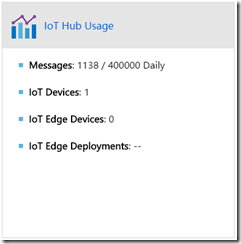.NET Core2使用Azure云上的Iot-Hub服务
基于工业4.0大背景下的工业物联网是近几年内热门的话题,依靠信息化技术企业可以实现数字化转型,生产可以实现智能化制造,设备可以实现自动化运作。然而,海量的数据采集是整个建设过程的基础环节,如何处理与利用这海量的数据是信息化技术中最重要的开发工作。那么,基于Azure国内云端的Iot-Hub服务是提供给开发人员另一个高效的数据处理方案,这里将通过代码的方式介绍如何将Iot-Hub服务集成到咱们的程序中来。
Azure云的Iot-Hub服务
Internet of things(简称Iot)物联网是新一代信息技术的重要组成部分。Iot-Hub是一个由微软提供的基于Azure云上的工业物联网解决方案,它可以大规模的管理Iot设备,可以与数百万的 IoT 设备建立双向通信,且支持各种操作系统和通信协议,另外它还能利用边缘计算实现更多的开发需要。如下是跟Iot-Hub相关的网址:
Iot-Hub官网(国内):https://www.azure.cn/zh-cn/home/features/iot-hub/
准备
这里将模拟一个iot设备上行到云端的demo,所以在着手开始实现之前咱们需准备一些必要的环境,如下:
1、在Azure上创建一个名为“myHub”的Iot-Hub服务,并将其的“连接字符串”获取,以备后用。
2、在”myHub”服务控制台内创建一个名为“myDevice”的设备,并将其的“连接字符串”获取,以备后用。
3、用VS2017开发工具创建两个基于.NET Core2的控制台程序,分别为:“Production”、“Consume”:
3.1、“Production”用来模拟Iot设备产生数据(运行于设备本地端),并将数据发送到Iot-Hub服务中,需在项目中通过Nuget管理器引用由微软提供的sdk类库“Microsoft.Azure.Devices.Client”。
3.2、“Consume”用来从Iot-Hub服务实时获取数据(运行于服务器云端),需在项目中通过Nuget管理器引用由微软提供的sdk类库“Microsoft.Azure.Devices”、“Microsoft.ServiceBus”。
实现
通过上述的准备后,咱们就可以进入具体的发布与集成工作了,如下:
1、“Production”端(运行在本地设备端)用于模拟设备产生数据的代码如下:
1 using Microsoft.Azure.Devices.Client; 2 using Newtonsoft.Json; 3 using System; 4 using System.Text; 5 6 namespace Production 7 { 8 class Program 9 { 10 //声明一个DeviceClient对象 11 private static DeviceClient deviceClient = null; 12 //创建一个定时器 13 private static System.Timers.Timer timer = new System.Timers.Timer(); 14 15 static void Main(string[] args) 16 { 17 //设备连接字符串,从设备控制台中获取 18 var conn = "HostName=myHub.azure-devices.cn;DeviceId=myDevice;SharedAccessKey=sReB225545Jl4Gw="; 19 //创建DeviceClient对象的实例 20 deviceClient = DeviceClient.CreateFromConnectionString(conn, TransportType.Mqtt); 21 timer.Interval = 5000; 22 timer.Elapsed += Timer_Elapsed; 23 timer.AutoReset = true; 24 timer.Start(); 25 var request = ""; 26 Console.WriteLine("输入exit则退出,并结束当前程序"); 27 do 28 { 29 request = Console.ReadLine(); 30 if (request.Equals("exit")) 31 { 32 Environment.Exit(0); 33 } 34 } while (true); 35 } 36 37 /// <summary> 38 /// 定时任务,模拟向Iot-Hub发送设备数据 39 /// </summary> 40 /// <param name="sender"></param> 41 /// <param name="e"></param> 42 private static async void Timer_Elapsed(object sender, System.Timers.ElapsedEventArgs e) 43 { 44 //创建一条数据 45 var model = new Info(); 46 model.Timestamp = DateTime.Now; 47 model.Val = new Random().Next(0, 2000); 48 49 var dataBuffer = JsonConvert.SerializeObject(model); 50 //将数据封装到Message对象 51 var eventMessage = new Message(Encoding.UTF8.GetBytes(dataBuffer)); 52 //通过DeviceClient将数据发送到云端 53 await deviceClient.SendEventAsync(eventMessage).ConfigureAwait(false); 54 } 55 56 } 57 58 /// <summary> 59 /// 实体对象 60 /// </summary> 61 class Info 62 { 63 public int Val { get; set; } 64 65 public DateTime Timestamp { get; set; } 66 } 67 } 68
2、“Consume”端(运行在服务器云端)用于消费来自Iot-Hub的代码如下:
1 using Microsoft.Azure.Devices.Common; 2 using Microsoft.ServiceBus.Messaging; 3 using System; 4 using System.Text; 5 using System.Threading.Tasks; 6 7 namespace Consume 8 { 9 class Program 10 { 11 static void Main(string[] args) 12 { 13 ReceiveCommands().Wait(); 14 } 15 16 static async Task ReceiveCommands() 17 { 18 //iot-hub服务连接字符串 19 var conn = "HostName=myHub.azure-devices.cn;SharedAccessKeyName=iothubowner;SharedAccessKey=km7jjceOUr+98865="; 20 //iot-hub服务内的设备名称 21 var device = "myDevice"; 22 //创建一个EventHubClient对象 23 var eventHubClient = EventHubClient.CreateFromConnectionString(conn, "messages/events"); 24 var eventHubPartitionsCount = eventHubClient.GetRuntimeInformation().PartitionCount; 25 //从指定的设备中获取数据 26 var partition = EventHubPartitionKeyResolver.ResolveToPartition(device, eventHubPartitionsCount); 27 var eventHubReceiver = eventHubClient.GetDefaultConsumerGroup().CreateReceiver(partition, DateTime.Now); 28 29 while (true) 30 { 31 try 32 { 33 //从Iot-Hub云端获取数据 34 var receivedMessage = await eventHubReceiver.ReceiveAsync(TimeSpan.FromSeconds(1)); 35 if (receivedMessage != null) 36 { 37 var messageData = Encoding.ASCII.GetString(receivedMessage.GetBytes()); 38 if (!string.IsNullOrEmpty(messageData)) 39 { 40 Console.WriteLine(messageData); 41 } 42 } 43 } 44 catch 45 { 46 } 47 } 48 } 49 50 } 51 } 52
3、分别运行“Production”与“Consume”端后,也可在Azure的Iot-Hub控制台查看实时报表,如下:
总结
1、通过Azure云端的Iot-Hub服务可以非常高效的实现Iot设备的管理与数据采集。
2、在.NetCore2程序中使用由微软提供的“Microsoft.Azure.Devices.Client”、“Microsoft.Azure.Devices”、“Microsoft.ServiceBus”类库,可以非常简便的在程序中集成Iot-Hub。
声明
本文为作者原创,转载请备注出处与保留原文地址,谢谢。如文章能给您带来帮助,请点下推荐或关注,感谢您的支持!



 浙公网安备 33010602011771号
浙公网安备 33010602011771号